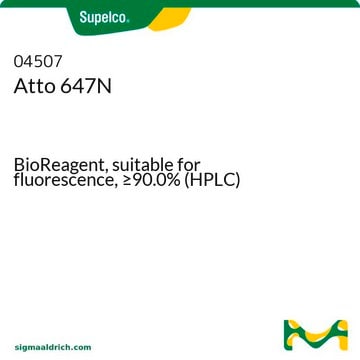93711
Atto 655
BioReagent, suitable for fluorescence, ≥85% (HPLC)
About This Item
Polecane produkty
linia produktu
BioReagent
Poziom jakości
Próba
≥85% (HPLC)
Postać
powder
producent / nazwa handlowa
ATTO-TEC GmbH
przepuszczalność
254 nm
655 nm
fluorescencja
λex 655 nm; λem 680 nm in 0.1 M phosphate pH 7.0
λ
in ethanol (with 0.1% trifluoroacetic acid)
absorpcja UV
λ: 652-658 nm Amax
przydatność
suitable for fluorescence
temp. przechowywania
−20°C
InChI
1S/C27H33N3O6S/c1-4-29-9-5-7-17-11-20-24(13-22(17)29)36-25-14-23-19(12-21(25)28-20)18(16-37(33,34)35)15-27(2,3)30(23)10-6-8-26(31)32/h11-14,18H,4-10,15-16H2,1-3H3,(H-,31,32,33,34,35)
Klucz InChI
FOYVTVSSAMSORJ-UHFFFAOYSA-N
Szukasz podobnych produktów? Odwiedź Przewodnik dotyczący porównywania produktów
Zastosowanie
Atto 655 shows a molar extinction of 110,000 and QY of 30% in water (50% in ethanol). Decay time is 1.9 ns.
Inne uwagi
Kod klasy składowania
11 - Combustible Solids
Klasa zagrożenia wodnego (WGK)
WGK 3
Temperatura zapłonu (°F)
Not applicable
Temperatura zapłonu (°C)
Not applicable
Środki ochrony indywidualnej
Eyeshields, Gloves, type N95 (US)
Certyfikaty analizy (CoA)
Poszukaj Certyfikaty analizy (CoA), wpisując numer partii/serii produktów. Numery serii i partii można znaleźć na etykiecie produktu po słowach „seria” lub „partia”.
Masz już ten produkt?
Dokumenty związane z niedawno zakupionymi produktami zostały zamieszczone w Bibliotece dokumentów.
Klienci oglądali również te produkty
Produkty
Fluorescence lifetime measurement is advantageous over intensity-based measurements. Applications include fluorescence lifetime assays, sensing and FLI.
Pomiar czasu życia fluorescencji ma przewagę nad pomiarami opartymi na intensywności. Zastosowania obejmują testy czasu życia fluorescencji, wykrywanie i FLI.
Nasz zespół naukowców ma doświadczenie we wszystkich obszarach badań, w tym w naukach przyrodniczych, materiałoznawstwie, syntezie chemicznej, chromatografii, analityce i wielu innych dziedzinach.
Skontaktuj się z zespołem ds. pomocy technicznej




